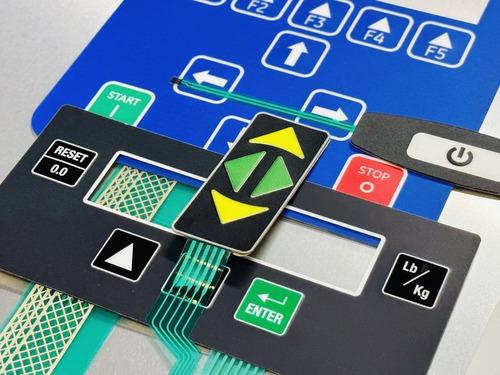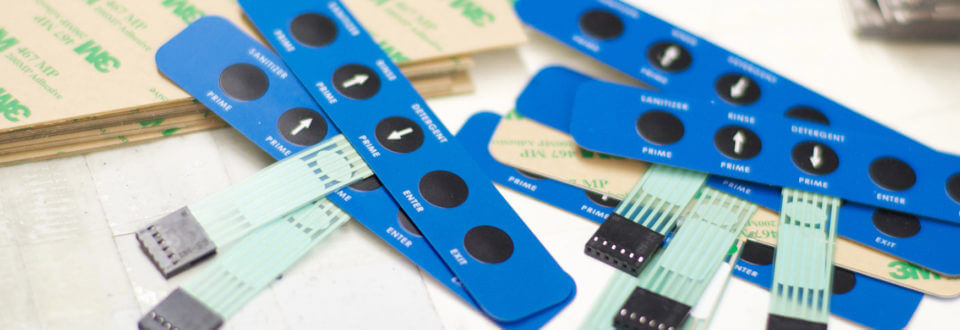Discover the Future of Control Interfaces: Why Membrane Layer Changes Are Acquiring Popularity
As sectors significantly prioritize easy to use and reliable control interfaces, membrane layer switches are arising as an engaging service that incorporates functionality with design adaptability. With the increase of smart technology and sustainability problems, the advancements and abilities bordering membrane layer changes warrant more detailed assessment.
Comprehending Membrane Layer Buttons
Membrane buttons are integral components in modern electronic devices, offering as user interfaces between users and makers. These switches contain multiple layers, normally consisting of a visuals overlay, a spacer layer, and a circuit layer. When a customer presses a button on the overlay, the leading layer makes contact with the circuit layer, completing a circuit and sending a signal to the tool. This simple yet reliable mechanism enables seamless communication with technology.

Toughness is another essential function, as membrane switches can be made to resist ecological factors such as moisture, dirt, and chemicals. This durability makes them ideal for applications in severe problems. In general, comprehending the structure and feature of membrane layer buttons is essential for appreciating their duty in the advancement of interface in today's technology-driven globe.
Key Advantages of Membrane Switches
Supplying a variety of advantages, membrane layer buttons have ended up being a favored choice in various applications (Membrane Switches). Among the key benefits is their portable layout, allowing makers to optimize space in tools without jeopardizing functionality. Membrane switches are light-weight, which is specifically valuable in mobile electronic tools

Furthermore, these buttons give outstanding durability. Built from adaptable products, they are resistant to dirt, dampness, and a variety of ecological variables, making them suitable for extreme problems. This resilience often translates into a much longer life expectancy compared to standard mechanical switches.
Additionally, membrane switches permit smooth combination of graphics and symbols, offering aesthetic adaptability and improving user experience. Customization choices are extensive, allowing brand names to produce distinct user interfaces that line up with their item identification.
Another secret advantage is their ease of cleansing and upkeep. The level surface of membrane changes prevents the buildup of dust and grime, making them suitable for hygienic atmospheres. Membrane switches are cost-efficient, as they can be generated in high quantities at reduced expenses, making them accessible for a vast variety of industries. These elements jointly add to their boosting appeal in contemporary control user interfaces.
Applications Across Industries

A myriad of markets are progressively adopting membrane buttons because of their adaptability and functionality. These regulate interfaces are particularly widespread in the automobile field, where they are used in control panels and infomercial systems, offering a smooth and user-friendly interface. In the clinical area, membrane layer switches over facilitate the procedure of analysis tools and individual tracking systems, guaranteeing dependability and simplicity of use in important scenarios.
Furthermore, the customer electronic devices market advantages from membrane layer switches in devices such as microwaves and remotes, enabling for streamlined design and boosted resilience. Membrane Switches. The aerospace field additionally makes use of membrane layer buttons in cabin controls, where area restrictions require small and effective design solutions
In addition, the commercial industry uses membrane switches in machinery control panels, offering durability against rough environments and making certain operational performance. Retail environments have actually welcomed membrane layer buttons in point-of-sale systems, improving user interaction while keeping visual allure.
Design Patterns in Membrane Buttons
Advancing along with technical improvements, design fads in membrane layer switches are increasingly focused on improving customer experience and visual allure. Modern membrane switches are being designed for simplicity and user-friendly use, enabling customers to navigate interfaces effortlessly. This change in the direction of user-centric design stresses tactile comments, making sure that users obtain immediate verification of their activities.
In addition, adjustable graphics and shades are coming read this article to be conventional features in membrane button layouts. This adaptability permits producers to produce tailored interfaces that straighten with branding and certain individual needs. The incorporation of backlighting is another famous fad, as it not only improves visibility in low-light problems yet also adds a visually striking aspect to the total style.
This shift not only improves visual appeals but likewise adds to the overall capability and sturdiness of the switches. These design fads collectively emphasize the growing value of combining kind and function in the growth of membrane layer buttons, ultimately improving the customer experience.
Future Expectation for Control Interfaces
The future of control user interfaces is poised for considerable makeover as arising technologies proceed to improve user interactions across different devices. The combination of sophisticated products, such as conductive inks and flexible electronic devices, will certainly enhance the convenience and functionality of membrane switches, making them progressively versatile to a variety of applications. Furthermore, useful link the increase of the Net of Points (IoT) will drive need for even more instinctive, user-friendly user interfaces that can effortlessly incorporate with clever tools.
As man-made intelligence and artificial intelligence progress, manage user interfaces will likely integrate more tailored functions, allowing customers to interact with devices in ways that are customized to their practices and preferences (Membrane Switches). This change towards user-centric layout will place membrane buttons as a crucial gamer in the marketplace, particularly in sectors like health care, auto, and consumer electronic devices
In addition, the promote sustainability will certainly urge manufacturers to explore environment-friendly materials and production methods, guaranteeing that the future of control interfaces aligns with environmental factors to consider. On the whole, as modern technology remains to development, membrane buttons will certainly become increasingly advanced, leading the way for innovative control remedies that improve customer experience and operational effectiveness across diverse markets.
Conclusion
In verdict, the enhancing fostering of membrane changes highlights their value in the advancement of control user interfaces. As easy to use interfaces become necessary in the context of IoT and AI developments, membrane buttons are placed to play a vital role.
As markets significantly focus on efficient and straightforward control user interfaces, membrane layer buttons are arising as an engaging remedy that incorporates capability with style flexibility.Durability is another key feature, as membrane layer buttons can be created to these details resist environmental factors such as dampness, dirt, and chemicals.Advancing along with technical developments, style trends in membrane layer switches are significantly focused on boosting user experience and aesthetic appeal. Modern membrane buttons are being created for simplicity and instinctive use, enabling individuals to navigate user interfaces easily. These design fads collectively emphasize the expanding importance of integrating kind and function in the growth of membrane layer switches, inevitably enriching the user experience.